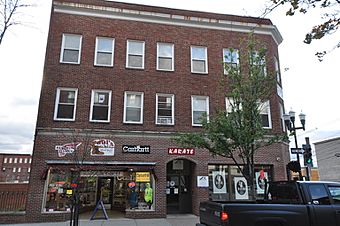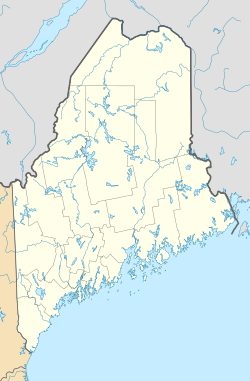Lower Lisbon Street Historic District facts for kids
Quick facts for kids |
|
|
Lower Lisbon Street Historic District
|
|
 |
|
| Location | West side of Lisbon St. between Cedar and Chestnut, Lewiston, Maine |
|---|---|
| Area | 2.5 acres (1.0 ha) |
| Architectural style | Classical Revival, Late Victorian |
| NRHP reference No. | 85001128 |
| Added to NRHP | May 21, 1985 |
The Lower Lisbon Street Historic District is a special area in Lewiston, Maine. It's like a time capsule of old buildings. This district is on the west side of Lisbon Street. It holds many commercial buildings built between 1850 and 1950.
These buildings show different architectural styles from that time. In 1985, this area was added to the National Register of Historic Places. This means it's an important place in American history. At first, there were 18 historic buildings. Sadly, many have been torn down since then.
Contents
Lewiston's Early Days
Lewiston became a city in 1850. It was a big center for making textiles. Textiles are fabrics like cloth. The city's downtown area grew along Lisbon Street. This happened from 1850 until about 1920.
Around 1920, the textile factories started to slow down. The upper part of Lisbon Street changed a lot over time. Many of its early buildings were replaced.
Why Lower Lisbon Street is Special
The lower part of Lisbon Street was different. It didn't change as much. This means many older buildings are still standing there. They show what the city looked like long ago.
The historic district covers one city block. It includes all the buildings on the west side of Lisbon Street. This is between Chestnut and Cedar Streets. Most of the old buildings on the other side of the street are gone.
Buildings in the District
When the district was listed in 1985, it had many brick buildings. Most of them were made of brick and stone. Out of 18 buildings, 12 were very important historically. Today, only seven of those buildings are still standing.
Oldest Buildings and Styles
One of the oldest buildings is from around 1850-1855. It's a wooden building with a pointed roof. Next to it are taller, four-story buildings. One of these was built in 1914. It has a Romanesque style. Another, from 1896, shows a Classical Revival style.
Further south are two more buildings. One is four stories tall. The other is one story. They have an Italianate style. However, their ground-floor shops have changed a lot.
Near the north end of the block are two three-story brick buildings. One of them is called the Centennial Block. It has a unique Gothic Victorian style. These buildings help us understand Lewiston's past.



